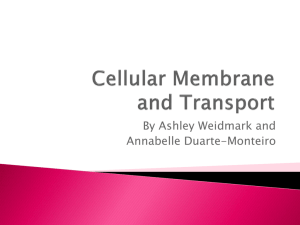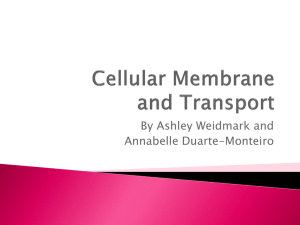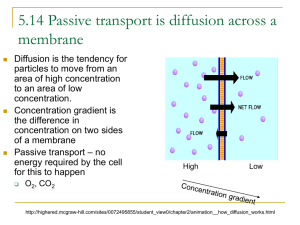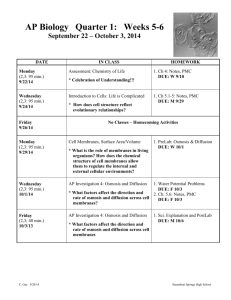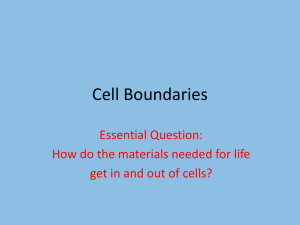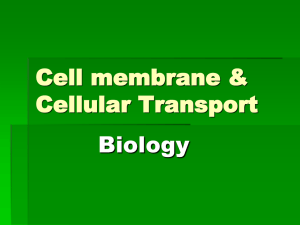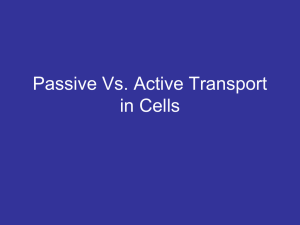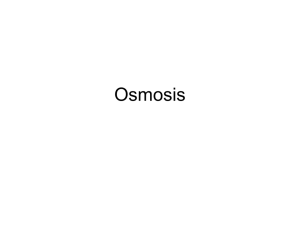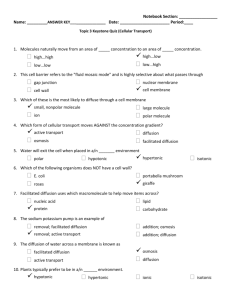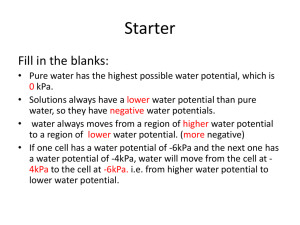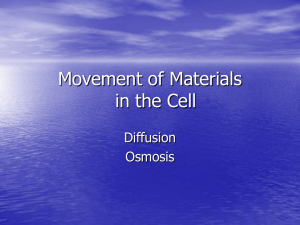Cellular Membrane and Transport
advertisement
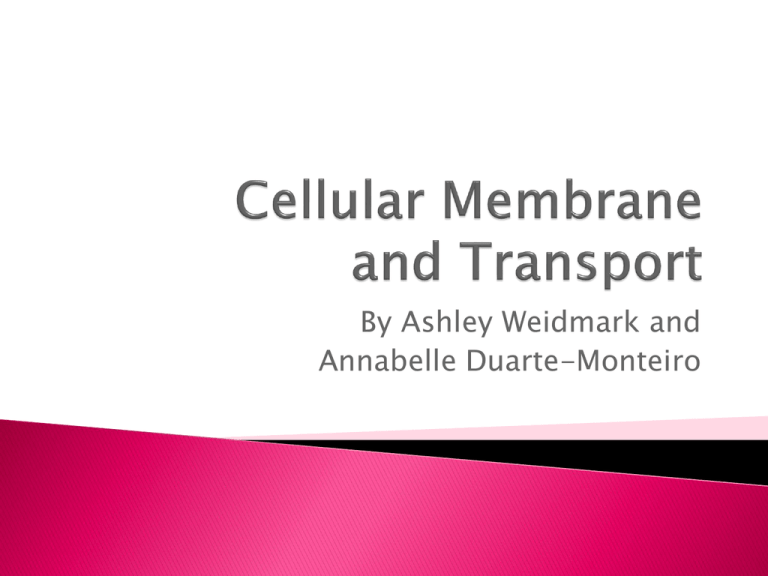
By Ashley Weidmark and Annabelle Duarte-Monteiro Cell Membrane and Transport Passive Transport Osmosis Simple Diffusion Active Transport Facilitated Diffusion Primary Active Transport Secondary Active Transport Membrane Assisted Transport Exocytosis Endocytosis B2.2 plan and conduct an investigation to demonstrate the movement of substances across a membrane (e.g., the effects of salt water and distilled water on a potato) [IP, PR] B2.5 plan and conduct an investigation related to a cellular process (e.g., factors that affect enzyme activity; factors that affect transport of substances across cell membranes), using appropriate laboratory equipment and techniques, and report the results in an appropriate format [IP, PR, C] B3.6 describe the structure of cell membranes according to the fluid mosaic model, and explain the dynamics of passive transport, facilitated diffusion, and the movement of large particles across the cell membrane by the processes of endocytosis and exocytosis Intro: Hook - Video on Fluid Mosaic Model http://www.youtube.com/watch?v=LKN5sq5d tW4 Read pp. 68-70 and Complete Review Questions: pp. 71 (Carter-Edwards, Trent, Susanne Gerards et al. Biology 12. 2011 ed. Toronto: McGraw-Hill Ryerson, 2011. Print.) Define Key terms pp. 72 (Carter-Edwards, Trent, Susanne Gerards et al. Biology 12. 2011 ed. Toronto: McGraw-Hill Ryerson, 2011. Print.) Complete Diffusion Activity (Gizmo) http://www.explorelearning.com/index.cfm?met hod=cResource.dspView&ResourceID=417 and student exploration sheet http://cs.explorelearning.com/materials/Diffusio nSE.pdf Complete Osmosis Activity (Gizmo) http://www.explorelearning.com/index.cfm?met hod=cResource.dspView&ResourceID=418 and student exploration sheet http://cs.explorelearning.com/materials/Osmosi sSE.pdf Review of 3 types of Passive Transport i.e. Simple Diffusion, Osmosis, Facilitated diffusion (channel proteins and carrier proteins) http://www.zerobio.com/flashmx/transport.swf Lab: http://library.thinkquest.org/27819/transport_ac ross_a_membrane_lab.html OR Lab: http://www.mrsec.psu.edu/museum/biology/pro cedures/membranes.pdf Read pp. 75-77 Complete Learning Check pp. 77 # 31-36 (Carter-Edwards, Trent, Susanne Gerards et al. Biology 12. 2011 ed. Toronto: McGraw-Hill Ryerson, 2011. Print.) Membrane Assisted Transport: Endocytosis/Exocytosis: http://www.maxanim.com/physiology/Endoc ytosis%20and%20Exocytosis/ee4.swf Teachers could also do a demonstration showing the process of osmosis. The following links are links to YouTube videos that demonstrate how to do a lab involving osmosis. Osmosis demonstration with a raw egg ◦ http://www.youtube.com/watch?v=0c8acUE9Itw Osmosis demonstration with potatoes ◦ http://www.youtube.com/watch?v=i0epq8J_K5k&fe ature=related Misconception #1: Facilitated diffusion uses Rectification #1: Facilitated diffusion only channel proteins. Active transport uses only carrier proteins. uses both channel protein and carrier proteins. The carrier protein can change conformation without ATP hydrolysis. Active transport uses only carrier proteins which can change conformation only upon ATP hydrolysis. Misconception #2: Passage of small, Rectification #2: Passage of small, hydrophobic molecules through the phospholipid bilayer is called “diffusion” hydrophobic molecules through the phospholipid bilayer is called “simple diffusion” The only safety concerns associated with this concept are outlined in the lab activity. ◦ Students must follow proper lab procedures and handle chemicals with care. ◦ All spills should be reported to the teacher immediately ◦ Students should wear safety goggles when handling chemicals. As learning: ◦ Assess the student worksheets completed with the Gizmo activity in lesson 2 ◦ Assess the lab report completed during lesson 3 ◦ During lesson 4, in small groups, students can make a T-chart comparing the different types of transport systems Of learning: ◦ Students can construct an interactive model or diagram of the cell membrane and all the transport systems. ◦ Paper and pencil test Students will understand how gases such as oxygen and carbon dioxide move in and out of blood. Students will understand the implication of certain poisons affecting these channels and therefore effecting the body’s electrical impulses.
